Gulf Oil Spill
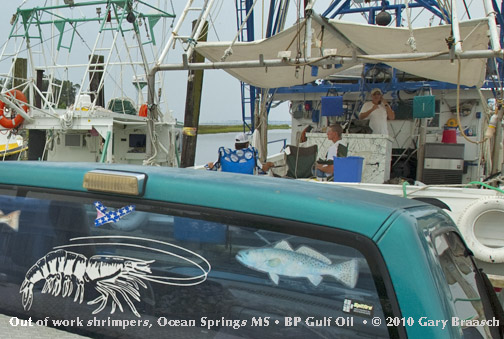
Out of work shrimpers at the dock, Ocean Springs MS July 24, 2010. The owners of the "Mark and Don" boat, 59 year old Ricky Ross and son Derick, signed a contract to work on oil spill clean up or booming, but never were called to work. So they have been idle the entire time, and are living on what they had saved. Their larger concern: "When we do start shrimping again, are people gonna buy 'em? They'll be scared of 'em." Also foreign shrimp imports are "the death of shrimping" here, they said.
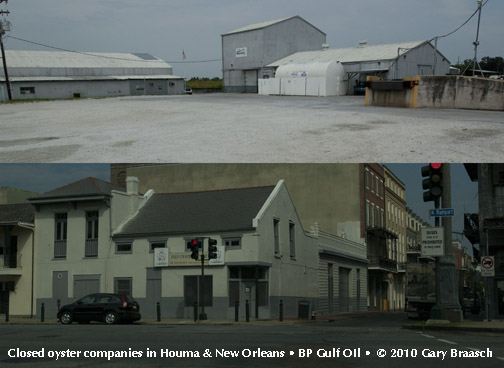
OIl pollution from the BP runaway well shut down oyster harvesting from April through August in most of the Mississippi Delta and the Gulf of Mexico. Releases of fresh water from the Mississippi River to help keep oil out of the river and bayous also are likely to have damaged some oysters also, because the bivalves depend on brackish water. A few areas under control of the state are now opening up, but the closure shuttered the famous P & J Oyster company in New Orleans and the Motivatit Oyster Company in Houma, throwing hundreds of oystermen shuckers and processors our of work.
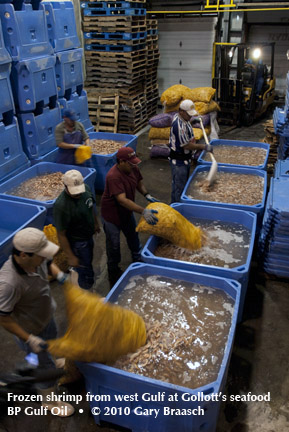
Shrimp season opened Aug 15 in central LA Delta and was also open in Mississippi. Few local boats were shrimping, for some out of fear the catch would be tainted or unsellable. At Gollott's Golden Gulf packing house, Biloxi, frozen shrimp from US waters near the Texas line were unloaded in mid-August. More boats are going out now, but catches are low compared to other years -- and very low compared to imported shrimp. Up through August 2010, 47,000 lbs of shrimp came in along the gulf according to the Natl Marine Fisheries Service (NOAA); but imported shrimp totaled more than 600,000 lbs just up through July.
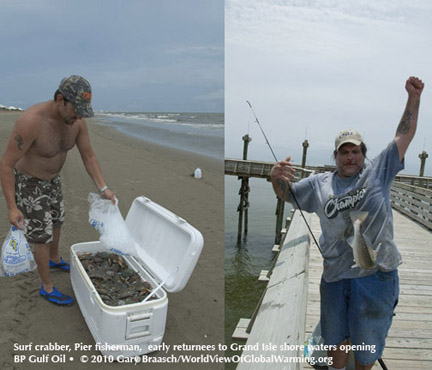
Grand Isle LA, Aug 10, 2010 The 7 mile beach is mostly cleaned of visible oil -- for now and on the surface only -- but only partly open to the public. One of the very few on the segment of beach opened was Ricky Breaux of Raceland LA, catching 12 dozen blue crab in less than two hours. He intended to eat them -- "I'm not worried. They opened the beach and there is a lot of water in the Gulf." His wife said later that family and friends did eat them all. Earlier, when sportfishing was opened on July 16, Joseph Causey was pulling in speckled trout after trout from the pier, and also was confident of their wholesomeness for his family.
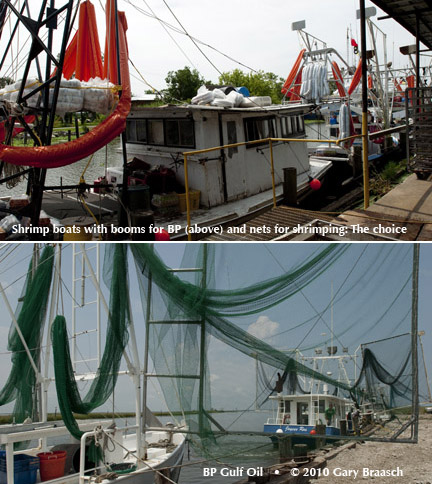
Shrimp season opened Aug 15 in central LA Delta, but only a few boats went out -- 5 of 20 that usually came to one packing house in Chauvin. As these boats show, photographed only a few miles apart in Chauvin, there was a choice to make to keep the booms and absorbent pads on board and work for BP contractors, or to rig the nets for shrimp. In mid August, Shrimpers mostly chose to keep working for the BP clean up. As of September 24, 92 percent of state waters are open to the harvest of finfish, crabs and shrimp. Areas near Southwest Pass and portions of state waters in the Barataria and Terrebonne Basins will remain closed. The area closed to all fishing in Federally controlled waters now measures 31,801 square miles (82,363 square kilometers) and covers about 13 percent of the US Gulf of Mexico fishing zone.
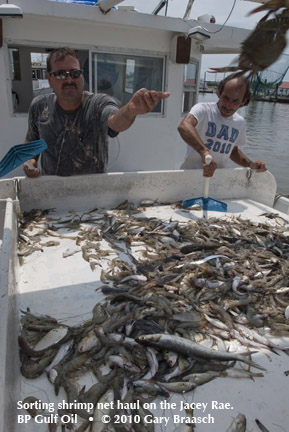
Shrimp season opened Aug 15 in central LA Delta, and Pat Duplantis and deckhand Ricky went out twice into Robinson Canal near Chauvin rigged with butterfly nets. They sort a 100 pound catch heavy with fish and crab, but earlier they brought in 500 lbs of shrimp: "A good sign of more to come," said Pat. Although NOAA and EPA continued testing waters and fish into mid-September and declaring most locations and catches safe, possible problems remained. One scientist writing in a medical journal voiced concern for shrimp, oysters, crabs, and other invertebrates she says have difficulty clearing their systems of dangerous polycyclic aromatic hydrocarbons that may still be in the waters suspended in tiny particles.
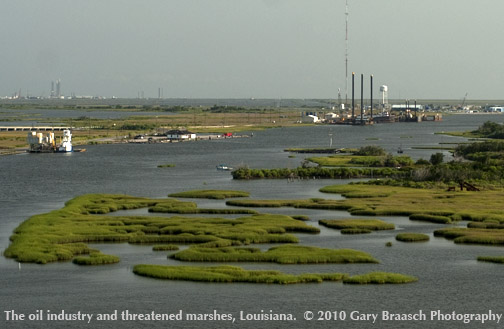
The oil and gas industry has been a part of the Gulf Coast and Louisiana for more than 100 years, and off-shore drilling was first begun in 1947. Now there are more than 4000 active drilling platforms in state and Federal waters in the Gulf, concentrated off of the Delta. The heavy industrial presence needed to drill offshore -- floating drill rigs, support ships, tankers, pipeline laying equipment and the facilities for thousands of workers -- can be seen everywhere across the marshes. Even though fishing is a big industry, employing an estimated 90,000 people in Louisiana, the income and influence of the offshore oil and gas industry which employs about half as many, is greater within the state.
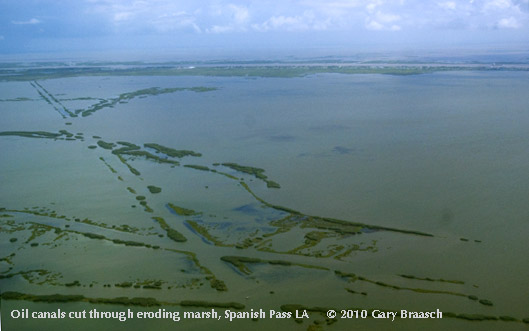
The the Mississippi Delta is suffering an ongoing loss of land at a rate of about 40 square miles each year. Brought on by man made changes in the flow of the Mississippi, the recent series of hurricanes since Katrina, natural subsidence and wave action, and oil drilling and ship activities, the delta's productive marshland is eroding away at a record pace. Oil and gas companies have been allowed to dig where they wanted, carving straight line canals and filling them with constant ship traffic to serve the offshsore rigs -- creating direct land loss and great erosion.
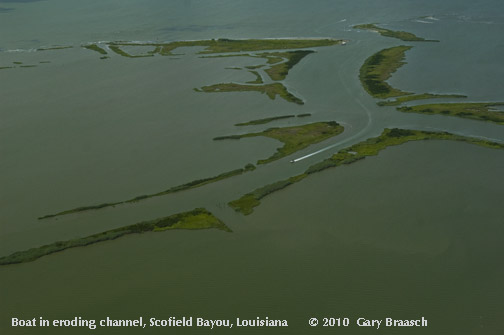
The delta's productive marshland is eroding away at a record pace. Accordiing to the Coastal Wetlands Planning, Protection and Restoration authority, "Louisiana has already lost coastal land area equal to the size of the state of Delaware. This loss is at an average rate of an acre every 38 minutes. If the current rate of loss is not slowed by the year 2040, an additional 800,000 acres of wetlands will disappear, and the Louisiana shoreline will advance inland as much as 33 miles in some areas." The straight line canals and constant ship traffic to serve the oil and gas industry are responsible for about a third of this land loss.
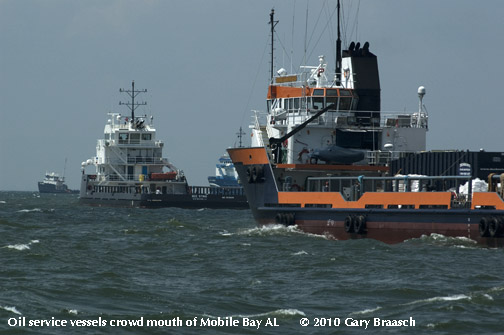
There are more than 4000 active drilling platforms in state and Federal waters in the Gulf, concentrated off of the Delta. The heavy industrial presence needed to drill offshore -- floating drill rigs, support ships, tankers, pipeline laying equipment and the facilities for thousands of workers -- can be seen everywhere across the region, including at the mouth of Mobile Bay, where oil service ships waited at anchor.
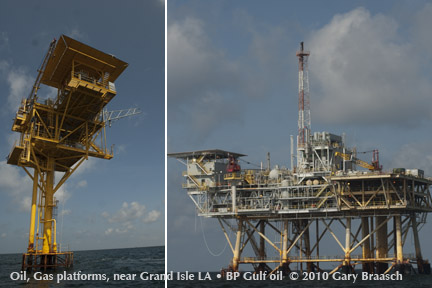
There are more than 4000 active drilling platforms in state and Federal waters in the Gulf, concentrated off of the Delta. The amount of oil drilled from the formations under the Gulf, in water ranging from a few feet to more than a mile (as with the Deepwater Horiizon rig) is about one-third of all American domestic petroleum production. But we use so much imported oil that that Gulf oil provides only about 8 percent of the liquid fuel we burn -- only 8 percent, putting at risk so much valuable water and land in the Gulf
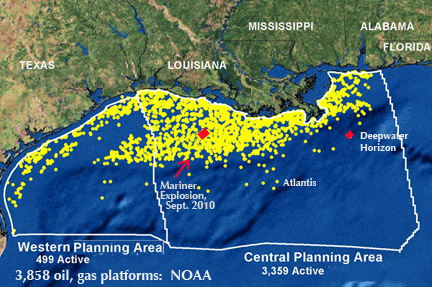
There are more than 4000 active drilling platforms in state and Federal waters in the Gulf, concentrated off of the Delta. The amount of oil drilled from the formations under the Gulf, in water ranging from a few feet to more than a mile (as with the Deepwater Horiizon rig) is about one-third of all American domestic petroleum production. But we use so much imported oil that that Gulf oil provides only about 8 percent of the liquid fuel we burn -- only 8 percent, putting at risk so much valuable water and land in the Gulf
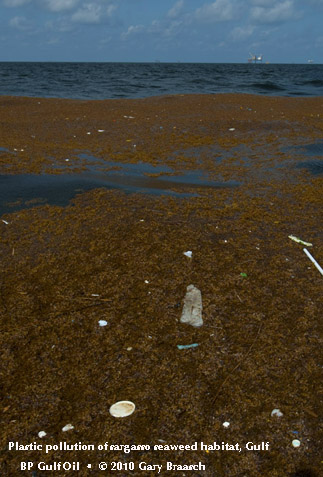
Among the natural resources put at risk from oil drilling and use in the Gulf is Sargassum floatiing seaweed. It accumulates in miles long rows along current and wind lines, is heavily affected by the oil spill and also by the contstant "oil spill" of throwaway plastic. It is habitat to young sea turtles, sea birds, small fish and the larvae of many creatures from crab to marlin and tuna. Many of the more than 500 oiled sea turtles were found in sargassum which had also trapped crude oil and sheen.
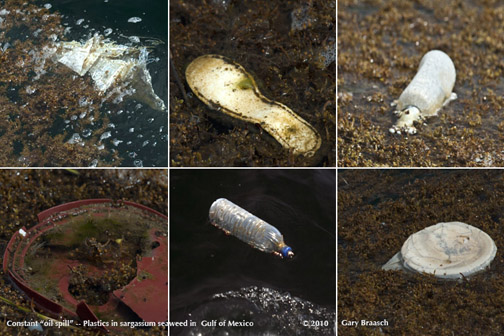
Montage of plastic trash found in sargassum seaweed, a very valuable habitat for young sea turtles, sea birds, small fish and the larvae of many creatures from crab to marlin and tuna. Many of the more than 500 oiled sea turtles were found in sargassum which had also trapped crude oil and sheen.
Photo Reports Intro
1. The BP Deepwater Horizon oil well gushes crude across the Gulf to beaches and marsh.
2. Crude comes ashore from Gulf Shores to Grand Isle.
3. Clean up workers and local people react to the oil.
4. Oil in the marshes greases up birds and sedges; fishing and shrimping are closed.
5. Shrimping and fishing begin to return but long term effects of oil remain.
5A. The toll on animals and birds continues; rescuers take action.
6. Indians Face Oil Spill
7. Indians Face Oil Spill 2
8. The most endangered sea turtle and the Gulf oil spill 1
9. The most endangered sea turtle and the Gulf oil spill 2
COPYRIGHT NOTICE:
Photography and text Copyright © 2005 - 2017 (and before) Gary Braasch All rights reserved. Use of photographs in any manner without permission is prohibited by US copyright law. Photography is available for license to publications and other uses. Please contact requestinformation@worldviewofglobalwarming.org. View more of Gary Braasch's photography here.


